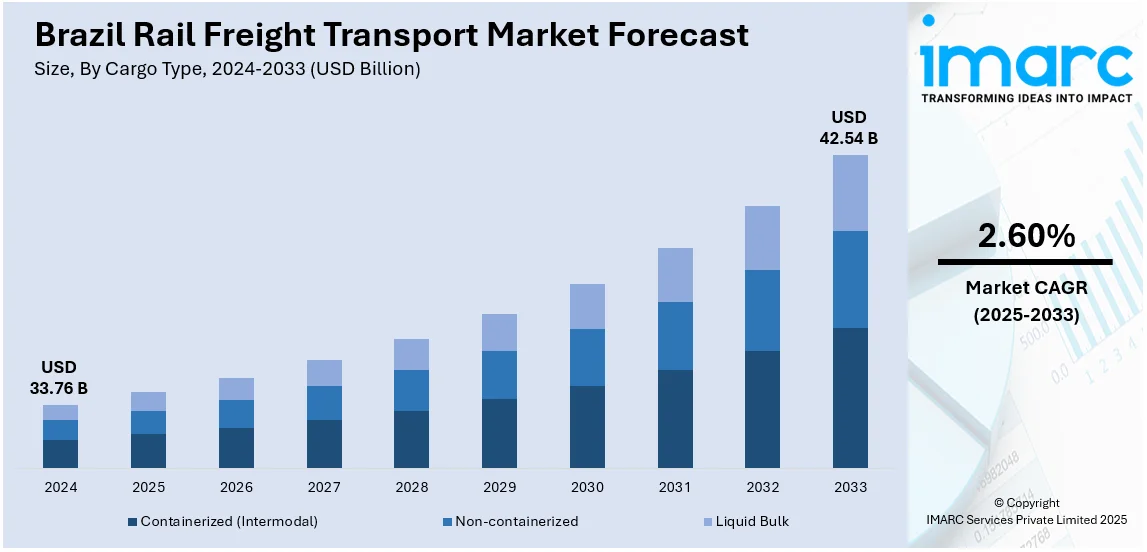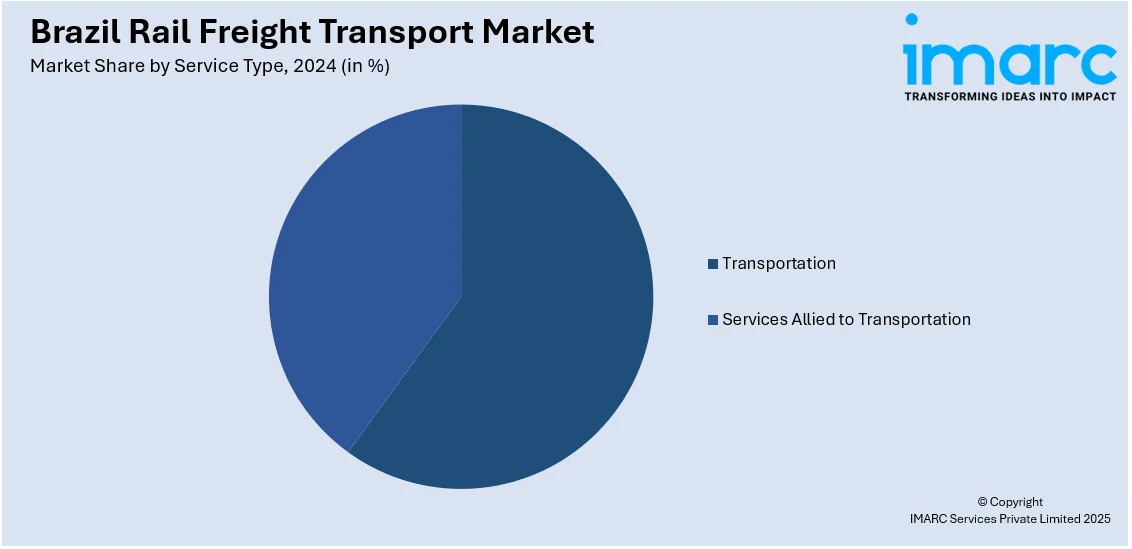
Brazil Rail Freight Transport Market Size, Share, Trends and Forecast by Cargo Type, Service Type, and Region, 2025-2033
Brazil Rail Freight Transport Market Overview:
The Brazil rail freight transport market size reached USD 33.76 Billion in 2024. Looking forward, IMARC Group expects the market to reach USD 42.54 Billion by 2033, exhibiting a growth rate (CAGR) of 2.60% during 2025-2033. The market is expanding on account of infrastructure investments, improved rail-port integration, and sustainability initiatives. Government and private sector efforts also enhance efficiency, reduce reliance on highways, and lower emissions. Moreover, strengthening rail networks supports economic growth, optimizes logistics, and increases competitiveness in domestic and international markets.
|
Report Attribute
|
Key Statistics
|
|---|---|
|
Base Year
|
2024 |
|
Forecast Years
|
2025-2033
|
|
Historical Years
|
2019-2024
|
| Market Size in 2024 | USD 33.76 Billion |
| Market Forecast in 2033 | USD 42.54 Billion |
| Market Growth Rate (2025-2033) | 2.60% |
Brazil Rail Freight Transport Market Trends:
Infrastructure Investments and Network Expansion
The Brazil rail freight transport market is benefiting from significant infrastructure investments aimed at modernizing and expanding railway networks. Government programs are encouraging private sector involvement in railway construction and management. Moreover, significant railway companies are putting money into track enhancements, signaling technology, and rolling stock to boost efficiency. An increase in intermodal connectivity, which combines rail with road and port logistics, is improving cargo transport, especially for bulk goods such as soybeans, iron ore, and fertilizers. These advancements are establishing rail as an economical substitute for road transport, lessening reliance on highways and alleviating congestion. As the railway network expands, the freight transport sector in Brazil is growing increasingly competitive and robust. In 2024, Brazil collaborated with the IDB to revitalize 10,000 kilometers of dormant railway segments. This effort seeks to enhance logistics effectiveness, decrease carbon emissions, and promote growth in the country. Feasibility studies will direct sustainable transport options to enhance Brazil's rail system.

Increase in Integration with Ports
The connection between Brazil's railways and ports is crucial for improving export efficiency, especially for bulk items such as minerals and agricultural products. The enhanced rail links provide an economical and time-efficient option compared to road transport, tackling constraints in the logistics chain. With improved access to key export centers, industries can transport larger quantities of products more quickly, satisfying the increasing global demand. Moreover, these rail-to-port connections minimize environmental effects by decreasing emissions and reducing fuel usage, aiding in more sustainable logistics practices. This integration enhances Brazil's competitiveness in international markets. For example, in September 2024, the Brazilian government accelerated the expansion of the Transnordestina railway to Pecém Port, with a projected cost of BRL 7 billion. This railway, measuring 1,209 kilometers, traversed Ceará, Piauí, and Pernambuco, with the goal of improving transportation logistics and fostering socioeconomic growth in the region. The initiative was expected to create approximately 4,000 employment opportunities in Ceará. The railway had a wide gauge to allow for bigger wagons and was included in Brazil's Growth Acceleration Program aimed at economic expansion and social inclusion.
Growing Focus on Sustainability
In Brazil, the movement towards rail as an eco-friendlier alternative to road transport is growing as businesses seek to achieve environmental goals and adhere to international sustainability criteria. Moreover, utilizing electric or hybrid trains in certain areas boosts the environmental advantages of rail travel. Rail's ability to transport heavy freight across extended distances also assists in reducing traffic congestion, which supports cleaner air and enhances public health. Correspondingly, Brazil's National Railway Plan 2023 seeks to boost rail's modal share from 17.7% to 34.6%. The strategy highlights the importance of drawing private investment and creating effective grain export routes. Brazil acknowledges the effectiveness of rail transport, which carries 17% of total freight and generates under 5% of CO2 emissions. Additionally, in September 2023, Brazil's Government revealed intentions to attract $36.6 billion in private funding for rail and road initiatives in the coming three years. The government intends to allocate an extra $15.4 billion, concentrating on enhancing the rail system to transport 40% of exports by 2035.
Brazil Rail Freight Transport Market Segmentation:
IMARC Group provides an analysis of the key trends in each segment of the market, along with forecasts at the regional level for 2025-2033. Our report has categorized the market based on cargo type and service type.
Cargo Type Insights:
- Containerized (Intermodal)
- Non-containerized
- Liquid Bulk
The report has provided a detailed breakup and analysis of the market based on the cargo type. This includes containerized (intermodal), non-containerized, and liquid bulk.
Service Type Insights:

- Transportation
- Services Allied to Transportation
A detailed breakup and analysis of the market based on the service type have also been provided in the report. This includes transportation and services allied to transportation.
Regional Insights:
- Southeast
- South
- Northeast
- North
- Central-West
The report has also provided a comprehensive analysis of all the major regional markets, which include Southeast, South, Northeast, North, and Central-West.
Competitive Landscape:
The market research report has also provided a comprehensive analysis of the competitive landscape. Competitive analysis such as market structure, key player positioning, top winning strategies, competitive dashboard, and company evaluation quadrant has been covered in the report. Also, detailed profiles of all major companies have been provided.
Brazil Rail Freight Transport Market News:
- In February 2025, COFCO International revealed a $240 million investment aimed at purchasing 979 wagons and 23 locomotives for its logistics activities in Brazil. This investment, in partnership with Rumo, seeks to move as much as 4 million tons of grain and sugar from farming areas to the Port of Santos, while cutting CO₂ emissions by 80%. This action bolsters COFCO's standing in Brazil's agribusiness sector and improves the logistics infrastructure of the nation.
- In October 2024, MRS Logística, a Brazilian freight railway firm, revealed their collaboration with Iridium to outfit its rail cars with satellite connectivity, improving real-time communication between train operators and control centers. The setup of Thales MissionLINK 700 devices by Iridium affiliate Satcom Direct Brasil facilitated data speeds reaching 704 Kbps, enabling internet connectivity, telemetry for rail maintenance, and voice communications. This partnership was established to enhance operational efficiency and safety for MRS Logística.
Brazil Rail Freight Transport Market Report Coverage:
| Report Features | Details |
|---|---|
| Base Year of the Analysis | 2024 |
| Historical Period | 2019-2024 |
| Forecast Period | 2025-2033 |
| Units | Billion USD |
| Scope of the Report |
Exploration of Historical Trends and Market Outlook, Industry Catalysts and Challenges, Segment-Wise Historical and Future Market Assessment:
|
| Cargo Types Covered | Containerized (Intermodal), Non-containerized, Liquid Bulk |
| Service Types Covered | Transportation, Services Allied to Transportation |
| Regions Covered | Southeast, South, Northeast, North, Central-West |
| Customization Scope | 10% Free Customization |
| Post-Sale Analyst Support | 10-12 Weeks |
| Delivery Format | PDF and Excel through Email (We can also provide the editable version of the report in PPT/Word format on special request) |
Key Questions Answered in This Report:
- How has the Brazil rail freight transport market performed so far and how will it perform in the coming years?
- What is the breakup of the Brazil rail freight transport market on the basis of cargo type?
- What is the breakup of the Brazil rail freight transport market on the basis of service type?
- What is the breakup of the Brazil rail freight transport market on the basis of region?
- What are the various stages in the value chain of the Brazil rail freight transport market?
- What are the key driving factors and challenges in the Brazil rail freight transport market?
- What is the structure of the Brazil rail freight transport market and who are the key players?
- What is the degree of competition in the Brazil rail freight transport market?
Key Benefits for Stakeholders:
- IMARC’s industry report offers a comprehensive quantitative analysis of various market segments, historical and current market trends, market forecasts, and dynamics of the Brazil rail freight transport market from 2019-2033.
- The research report provides the latest information on the market drivers, challenges, and opportunities in the Brazil rail freight transport market.
- Porter's five forces analysis assist stakeholders in assessing the impact of new entrants, competitive rivalry, supplier power, buyer power, and the threat of substitution. It helps stakeholders to analyze the level of competition within the Brazil rail freight transport industry and its attractiveness.
- Competitive landscape allows stakeholders to understand their competitive environment and provides an insight into the current positions of key players in the market.
Need more help?
- Speak to our experienced analysts for insights on the current market scenarios.
- Include additional segments and countries to customize the report as per your requirement.
- Gain an unparalleled competitive advantage in your domain by understanding how to utilize the report and positively impacting your operations and revenue.
- For further assistance, please connect with our analysts.
 Inquire Before Buying
Inquire Before Buying
 Speak to an Analyst
Speak to an Analyst
 Request Brochure
Request Brochure
 Request Customization
Request Customization




.webp)




.webp)












